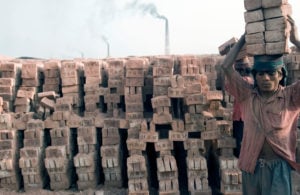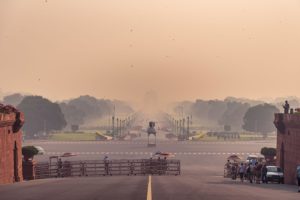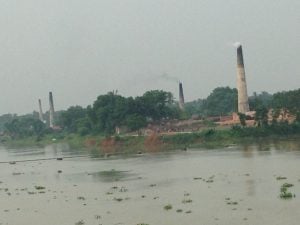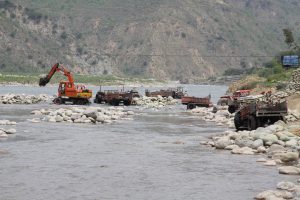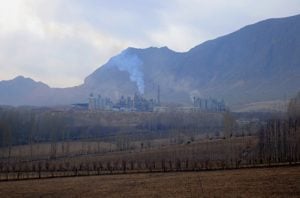In Bangladesh, the mere act of breathing is hazardous. In 2017, air pollution was responsible for 14% (123,000) of total deaths. The country’s air quality has worsened since, with more than 170,000 people dying due to diseases related to air pollution in 2019.
Recognising the scale of the problem, the government is seeking to clean up one the most polluting industries: brick kilns.
Dhaka, the capital of Bangladesh, is one of the world’s most polluted cities. There are more than 1,000 brick kilns in and around the city, Md Abu Bakar, secretary-general of the Bangladesh Brick Manufacturing Owners Association, told The Third Pole.
The kilns burn coal and wood to fire topsoil and create traditional clay bricks – which are in high demand as the country develops and its cities expand. The impact on the environment and human health is enormous: in 2018, Bangladesh’s brick sector burnt 7 million tonnes of coal and emitted more than 21 million tonnes of carbon dioxide – more than the total CO2 emissions of Guatemala.

Research conducted in 2014 by the country’s Department of Environment in association with the Norwegian Institute for Air Research and the World Bank found that brick kilns are the source of most of Dhaka’s air pollution – responsible for 58% of fine particles.
The problem shows no sign of diminishing. By 2030, it is projected that 60 billion bricks will be produced in Bangladesh, almost doubling from around 34 billion in 2018.
There are nearly 8,000 coal-fired kilns in Bangladesh. To fire bricks, coal and wood is burnt, which releases greenhouse gases and contributes to deforestation.
The industry uses outdated, inefficient technology, making it more resource-intensive and polluting
Kilns emit particulate matter and black carbon, which are hazardous to human health
A huge amount of topsoil is stripped off the land to create bricks. According to Akhter Hossain Sarker, principal research officer at the Housing and Building Research Institute, 60 million tonnes of topsoil is used by the brick industry every year. Use of topsoil in this way leads to a loss of fertile agricultural land – crops cannot be grown for three years afterwards. The loss of topsoil also leads to a loss of land elevation, increasing exposure to sea-level rise and flooding.
Enter ‘alternative bricks’
In its seventh five-year plan (2016-20), the government set out the aim to bring down pollution from the brick sector to zero by 2025. To meet Bangladesh’s growing demand for construction material while bringing air pollution under control, the government has invested in and is promoting “alternative bricks”: blocks that have not been kiln-fired.
For the past six years, the House Building Research Institute (HBRI), a government research institute, has been working on the development of what it says are less-polluting building materials.
There are many types of non-fired bricks, but all use varying quantities of cement, combined with sand, stone chips, dredged riverbed material and other substances.
As of 2019, these bricks’ market share remains low, at 0.5%. Shaymal Barman, an expert on Bangladesh’s brick sector and coordinator at the Private Financing Advisory Network (PFAN), told The Third Pole that compressed concrete blocks (made from cement and coarse sand) account for the bulk of this. But this could soon change. In November 2019, the government announced that by 2025 all state construction projects would only use alternative bricks.
Sharif Ahmed, minister for housing and public works, said: “We are stressing the need to make environment-friendly construction materials… We have been working on spreading the activities of HBRI across the country in order to strengthen it.”
Until recently, blocks made from dredged riverbed material and hollow concrete blocks were made manually. As of April 2021, machines developed by the HBRI are speeding up production: one machine can produce nearly 20,000 bricks a day.

Akhter Hossain Sarker, principal research officer at the HBRI, said that with government assistance Bangladesh could make billions of alternative bricks in the next year.
“You can assume that government building is 10% of the total demand,” said Barman, which under the government’s schedule would mean that around 4 billion alternative bricks are produced annually by 2025. Currently, he said, achieving this is hampered by a lack of factories and need for further investment – as well as whether government procurement units follow the guidelines. (As of January, only 13% of the target for the fiscal year had been achieved, according to the Bangladesh Concrete Block Association.)
In 2016, the World Bank and Bangladesh’s Department of Environment signed an agreement with the HBRI. It provided finance of USD 588,410 to the HBRI, to be used to increase the production of alternative building materials.
To promote alternative bricks, the HBRI provides technical support to the private sector and entrepreneurs, supplying technology, machinery and training for free. According to the HBRI, about 20 private construction companies in Bangladesh plan to make alternative bricks.
Sarker also said that at least 100 traditional brick kiln owners have started to make ‘eco-bricks’.


Cement’s high carbon footprint
“Since riverbed soil is being used to produce the alternative bricks, it helps save the topsoil and the environment,” said Sarker from the HBRI, adding that alternative bricks “do not require topsoil and firewood and so there is no question of pollution”.
However, all of the non-fired bricks use cement. And, globally, the production of cement contributes an enormous 8% of CO2 emissions.
Kiran Pereira, founder of Sand Stories, an organisation dedicated to exploring the human and environmental impacts of sand extraction, said: “The world is moving away from cement and concrete right now, and this is clearly at odds with that. There’s a real danger that they might just transpose the problem elsewhere.”
• Limestone, aluminium, sand and other minerals are heated to form clinker – a hugely carbon-intensive process
• Clinker is mixed with gypsum to form cement
• Cement is the fine powder that glues together sand and gravel to make concrete.
Pereira said: “When you mix cement, yes there’s no heating involved. But to produce that cement accounts for about 8% of global carbon emissions.” She pointed out that making clinker, an essential ingredient in cement, “is hugely carbon-intensive. You might not see it, but a lot of coal is used in producing that clinker.” As a result, by turning to cement-based blocks Bangladesh, which is already one of the largest importers of clinker in the world from China, India and Southeast Asia, may relocate its pollution problems to those countries.
Will alternative bricks mean more dredging?
There is also an environmental impact from increased dredging for sand and riverbed material. The main use of dredged soil is in compressed stabilised earth blocks (CSEB), which are composed of 80-90% riverbed material, and 20-10% cement.
“CSEB has practically no market share. It is not commercially produced as of yet. Only HBRI and another one company produce CSEB,” said Shaymal Bamran, estimating that only a few thousand pieces are made every year.
While CSEBs are currently a fraction of the mix, that could change soon under the plan to accelerate alternative brick production.
We are already concerned about the potential environmental and ecological damage of using river sands for ‘eco-friendly’ brick productionSheikh Rokon, Riverine People
In 2019, the National Parliament of Bangladesh amended the Brick Manufacturing and Brick Kiln Establishment (Control) Act, 2013. Sheikh Rokon, secretary general of Riverine People, a Dhaka-based civil society organisation, said that under the previous act, extracting soil from water bodies was prohibited “without the permission from the proper authority”. Now, he said, permission is needed only from the district commissioner. “The amendment has made extracting sand from rivers for brick kilns from easier. Because it is the DCs who are most responsible on the government part for allowing or not applying the law in cases of indiscriminate sand mining in rivers across the country.”
The HBRI told The Third Pole it is not yet known how much sand and riverbed material could be dredged if the bricks are rolled out widely.
Coarse sand is needed to make compressed concrete blocks, used mainly to build urban housing. This type of sand is only found around two mining sites, in hilly areas of the northeast division of Sylhet, according to Shaymal Barman.
Fine sand is found in the south of Bangladesh, where the majority of dredging is required – particularly in Khulna division – according to Barman. As the dredged soil is often a mixture of clay, sand and silt, its main use is to make CSEBs and fill floodplains for construction. The solid CSEB blocks are heavy and only suitable for one or two-storey housing in mostly rural areas.
Bangladesh has more than 400 major rivers. The braided, meandering river system routinely drowns and recreates short-lived river islands with silt.
Tuhin Wadud, a Dhaka-based river activist, told The Third Pole that if the rivers are properly managed by removing deposited silt, their depth and flow will be maintained, and thus will remain healthy. Wadud added that this will bring benefits to riverine ecosystems, agriculture and navigation.
Md Ataur Rahman, professor of water resources engineering at the Bangladesh University of Engineering and Technology (BUET), said that the impact of sand mining depends on the river. For example, he said, the Surma River of Sylhet division in northeast Bangladesh is not wide, so sand mining should not be the same as the Jamuna River, which is a big river.

But others are less ambivalent on the impact of sand mining and dredging. “We are already concerned about the potential environmental and ecological damage of using river sands for ‘eco-friendly’ brick production,” said Rokon.
Sediment, which carries nutrients down rivers, is the basis of riverine food chains – and the productivity of fisheries depends on it. Pereira pointed out: “Fishing is really important in Bangladesh. Fish provides about 55% of the animal protein intake for people. And dredging and fish habitat don’t go well together. You will end up disrupting their habitat completely, especially fish that are sensitive to disturbance.” She added that dredging rivers brings up pollutants and refuse that have sunk to the bottom of the riverbed. Even organic material brought to the surface will consume oxygen as it rots, leaving less for marine life.
“Everything below water will be impacted,” said Pereira. “I understand the need for navigation and to make rivers wider, but it comes at a cost, and this should be made explicit.
“I suspect that air pollution from [clay] bricks is a more tangible problem; people feel it in their everyday lives and experience the effects so believe this is more eco-friendly.”
Rokon said: “Indiscriminate sand mining has already become the single biggest threat for the rivers of Bangladesh,” adding that “river dredging for ‘eco-friendly’ bricks will definitely worsen the situation”.
Dredging and the delta
Sand, silt and clay are already extracted from Bangladesh’s rivers. The dredged material is used to fill low-lying land and level it for construction.
In Bangladesh’s 2018-19 National Budget speech, it was announced that 10,000 kilometres of river routes, covering 178 rivers, would be dredged by 2025. So far more than 65 dredging projects have taken place under the plan, according to a statement in parliament by the state minister for the Ministry of Shipping.
“Dredging is a must,” said Barman. “We have hundreds of rivers bringing many materials. As they meet the sea they deposit the silts and sands and it clogs up, and there is a risk of flooding, and some rivers are becoming very narrow.” As dredging is expensive and will be carried out regardless, he said, it makes sense to use the dredged material in construction – rather than leave it on the riverbank where it can be washed back into the river.
“We need to do a lot more dredging, so we can revive the rivers. If you avoid ecologically important areas then it’s not a problem.”
If you extract sediment to avoid emissions on the floodplain, but you create erosion that reduces mangroves – you’re moving the problem, not solving it.Marc Goichot, WWF
Marc Goichot, freshwater lead for Asia-Pacific at WWF, urged for a more holistic understanding of the Ganga-Brahmaputra delta. Freshly deposited sediment, he said, has a structural role in the stability of riverbanks. “Taking sediment out leads to changes, increases erosion and increases salt intrusion… It’s pretty clear that sediment reduction will reduce resilience [to cyclones and extreme weather].
“We look at the negative aspects of floods, which sometimes exist but usually the negative aspects are what is called ‘artificial floods’ – not natural in the sense that they are exacerbated by changes in the riverbed.” Natural flooding acts as a pump, he said, that both fertilises and creates land. Dredging “is basically recreating nature at a very high-energy cost because moving sediment is expensive.”
For example, Goichot said, mangroves improve coastal resilience to extreme weather. But they cannot survive without sediment. “If you extract sediment to avoid emissions on the floodplain, but you create erosion that reduces mangroves and resilience then that’s not a good outcome – you’re moving the problem, not solving it.”
“The condition of the rivers of Bangladesh is fragile in any consideration,” said Rokon, from Riverine People. “Hundreds of rivers of Bangladesh are experiencing erosion, biodiversity losses and pollution due to indiscriminate sand mining. Some of the small rivers have lost the natural structure of the riverbed. It is impacting adversely the cropping and habitations of communities across the country.”
Before introducing more dredging, Goichot urged authorities to carry out a delta-wide “sediment budget”. This would give policymakers a tool to monitor the volume and quality of sediment, and not go beyond certain thresholds.
Rahman, the professor from BUET, said: “When we consider a river for sand mining, we calculate the nature of the river with mathematical modelling.”
Need to regulate sand mining
As demand increases for sand and riverbed material, illegal riverbed mining could rise.
Syeda Rizwana Hasan, chief executive at the Bangladesh Environmental Lawyers Association, said that sand mining is largely unregulated. “There is no reflection of any policy of Bangladesh regarding sand mining,” she said. “Although some steps have been taken, the criminals remain out of reach under the political backup. As a result, illegal sand mining is not stopping. There should be specific policies to stop illegal sand mining and it should be controlled by strict enforcement of the law.”
“The High Court division of the Bangladesh Supreme Court has issued directives to stop sand mining several times, but sand miners seem unstoppable,” said Rokon.
Akhter Hossain Sarker said the HBRI and other agencies are currently working with the Bangladesh Inland Water Transport Authority (BIWTA) and the Bangladesh Water Development Board to formulate guidelines to control illegal and indiscriminate sand mining. By 2022, he said, they hope to start implementing the sand mining guidelines all over the country with the help of the Department of Environment.
Alternative bricks: low price, but at what cost?
The average cost of making a traditional brick is 11 Bangladeshi takas (0.13 US dollars). Compressed concrete and CESB bricks cost only BDT 6 (USD 0.071), said Sarker, the HBRI’s research officer.
“Sand can be extracted from rivers at little price. Alternative bricks don’t need to be fired. Traditional bricks are made manually. And alternative bricks are made in automatic machines. It saves time and labour, so it is cheaper,” explained Sarker. Transport costs are also lower, and bricks can be made near to extraction sites.
But the low price of the bricks may come at a higher cost. Aside from the environmental impact, there are questions over the safety of bricks made from sand, riverbed material and cement. There are numerous reports of buildings made from sand mixed with cement collapsing.
“We do check the strength of the blocks and it is normally higher than that of the traditional solid type,” said HBRI’s principal research officer Akhter Hossain Sarker.

But “if the proportion of material is not right, the material can collapse or become brittle and less strong. Maybe they can absorb a lot of water and then the structure is weakened even further,” conceded Shaymal Barman. “For sand-cement-type-based products the main problem is the mixing. In Bangladesh there is not a proper standard as of yet, they use cheap machines where the mixing is by hand… That’s why we have proposed mechanisation of the process from the mixing to the compression.”
CSEB blocks that contain more than 20% sand can crack, said Barman. Due to their weight, CESB blocks (which are heavier than traditional clay blocks) can only be used in one or two-storey buildings in rural areas, and are not suitable for high-rise buildings, where lightweight concrete is needed. Because of this, he said, CSEBs will most likely be used mainly by the government and NGO-funded projects.
“We need lightweight concrete blocks and we need to do some technology innovation to use this dredged soil properly and maybe to tackle issues with the CSEBs,” Barman said.
There are other options
Hasan, of the Bangladesh Environmental Lawyers Association, told The Third Pole that one immediate step to address air pollution is to amend the Brick Manufacturing and Brick Kiln Establishment (Control) Act 2013. In this, she said, the authorities need to declare the most polluting brick kilns illegal.
Overall, the news that authorities want to create environment-friendly buildings should be welcomed.
If you want to make a big change [construction] is the sector to focus your energy onKiran Pereira, Sand Stories
But the choice does not have to be between heavily polluting clay bricks and increased river dredging for materials. “It’s great that they are trying to find something more sustainable… but maybe the option would be to look at others,” said Goichot, adding that compressed wood can be as strong as concrete.
Pereira pointed out that vernacular architecture (characterised by its reliance on needs, construction materials and traditions specific to a particular area) might offer a lot of solutions. “The west is turning to building with straw bales, timber, there’s huge movements in Europe to put a tax on embodied carbon emitted when cement is manufactured.” With the building industry responsible for 40% of global carbon emissions, “if you want to make a big change this is the sector to focus your energy on”, she stressed.
“It’s possible to build well, live well with bio-based materials, with local materials.” She gave the example of a school built in 2007, where the architect worked with villagers and used traditional architecture such as mud and bamboo, which has survived nearly 15 monsoons. “If you build with local materials, that are easily accessible, where there is local skill to use those materials, it’s a building that is truly sustainable.”
Note: This article was updated on 31 August 2021, 22.48 IST to include comments from Sheikh Rokon of Riverine People
